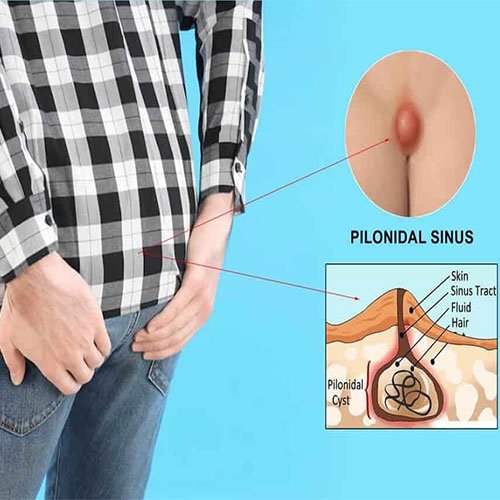
Pilonidal Sinus
Pilonidal Sinus
A Pilonidal Sinus (PNS) is a small tunnel or cavity that forms under the skin, typically near the tailbone at the top of the buttocks. It’s often filled with hair, debris, and skin cells, leading to discomfort, infection, and potential abscesses if left untreated. The term “pilonidal” means “nest of hair,” which is fitting, as the condition often involves hair growth within the sinus cavity, irritating the surrounding tissue. The sinus tract can lead to recurrent infections, causing swelling, pain, drainage of pus or blood, and foul odor.
When to See a Doctor
If you notice pain, swelling, or discharge near the tailbone area, especially if it’s recurrent, consulting a healthcare provider is essential.

Causes
The exact cause of pilonidal sinus is not fully understood, but several factors contribute:
- Hair growth: Hair that penetrates the skin can trigger a foreign body reaction, leading to infection.
- Friction and pressure: Sitting for extended periods or wearing tight clothing can cause hair to penetrate the skin.
- Hormonal changes: Commonly seen in young adults, likely due to hormonal changes and increased body hair.
- Genetics: Family history can increase susceptibility to developing PNS.
Symptoms
- Pain and tenderness near the tailbone, especially when sitting
- Swelling or redness around the affected area
- Discharge of pus or blood from an opening in the skin
- Foul odor if the sinus is infected
- Fever in severe cases if infection spreads
Treatment Options
Conservative Management
- Cleaning: Keeping the area clean and dry is essential to prevent further infection.
- Shaving: Regular hair removal around the sinus area can help reduce irritation.
- Antibiotics: Antibiotics are used in the early stages if there’s mild infection, though they may not treat the sinus itself.
Drainage of Abscess
If an abscess forms, a minor surgical procedure can drain the pus and relieve pain. However, this may not eliminate the sinus and can result in recurrence.Surgical Excision
For persistent or recurrent cases, surgery is often recommended. There are several surgical options:- Excision with Open Healing: The sinus is removed, and the wound is left open to heal naturally. This reduces the risk of recurrence but takes longer to heal.
- Excision with Primary Closure: After removal, the wound is closed with sutures, leading to faster recovery, but there’s a slightly higher risk of recurrence.
- Flap Surgery: This involves excision followed by closure using a nearby tissue flap, which helps reduce tension on the wound, speeds healing, and lowers recurrence rates.
Minimally Invasive Treatments
- Laser Treatment: A minimally invasive option where a laser is used to seal the sinus tract. This reduces pain and recovery time but may not be suitable for larger or complex sinuses.
- Endoscopic Treatment: Tiny instruments and a camera are used to clean and remove the sinus tract. It is less invasive, but long-term results vary.
Aftercare and Prevention
Post-treatment, proper wound care is crucial to ensure healing and prevent recurrence. Here are some preventive steps:
- Maintain proper hygiene in the area.
- Regularly remove hair around the affected area.
- Avoid prolonged sitting to reduce friction.
- Maintain a healthy weight to decrease the risk of recurrence.
